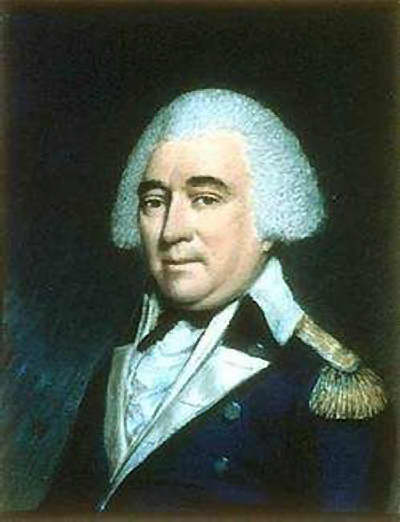|

"Our Heritage" In 1979 during the Wayne County bicentennial I wrote a feature article about General Anthony Wayne, the man for whom Wayne County was named. The county seat of Wayne County from 1787 to 1847 was named Waynesborough for General Wayne's birthplace and ancestral home in Chester County, Pennsylvania. The victory of General Wayne over the British at Stony Point, New York, on July 15, 1779, inspired the residents of the new county to name the county for him. Anthony Wayne was born on January l, 1745, and he was the son of Isaac and Elizabeth Iddings Wayne, and a grandson of Anthony Wayne who migrated from Ireland. The pioneer grandfather built Waynesborough in Chester County, Pennsylvania in 1715. Young Anthony Wayne attended the local academy and then went to the University of Pennsylvania where he learned to be a surveyor. On March 26, 1766, he was married to Mary Penrose in Christ Chapel Church in Philadelphia. In 1767 Wayne headed a company supported by Dr. Benjamin Franklin to colonize Nova Scotia. This project was not too sucessful. In 1774 he took over his father's farming and tannery interests. In 1774 Anthony Wayne was elected to the Pennsylvania Assembly. By this time he had already embraced the American cause. He organized a military company in 1775 and in 1776, he was made a lieutenant colonel of the 4th Pennsylvania Battalion. He was engaged in the campaign in Quebec and later at Fort Ticonderoga, where he was promoted to the rank of brigadier general in February 1777. He later joined General Washington in the campaign around Philadelphia and spent the winter of 1777-78 at Valley Forge. General Wayne had a part in the campaign against Sir Henry Clinton in New, Jersey. In June, 1779, General Washington ordered him to take command of the infantry at West Point, N.Y., and on the night of July 15, 1779, General Wayne stormed the well-defended British fort at Stony Point and he captured the fort as well as prisoners. This was one of the great American exploits of the war. Wayne was commended by Washington and received the thanks of the Continental Congress. In 1781 he was ordered to Virginia where he took part in the campaign at Yorktown. In 1782 he was ordered to Savannah, Georgia, to serve under General Nathaniel Greene. In 1783, he was appointed to the rank of major general. In 1785 he went to live on his plantation in Georgia. While there he was elected to Congress, but he served only one year since his residence was in question. Even after the Treaty of Peace with the British in 1783, the British still occupied forts in the northwwest territory and continued to incite Indians against the Americans. Washington ordered General Wayne to command the U.S. troops in the northwest. He subdued the Indians. While serving in this capacity, he died at Presque Isle, Pennsylvania on December 15, 1796, and he was buried there. His remains were reinterred at St. David's Episcopal Churchyard at Radnor, Pennsylvania, on July 4, 1808. General and Mrs. Wayne had a son, Isaac, and a daughter, Margaretta. Earlier this year, a park at the site of the old town of Waynesborough in Wayne County was dedicated. On September 17th of this year, the D.A.R. Chapter of Wayne County are planning a celebration there to commemorate the 200th anniversary of the signing of the U.S. Constitution on September 17, 1787.
Findagave Contributed by Carolyn Shank Raleigh Minerva, June 21, 1811 MONUMENT TO GENERAL WAYNE On the 5th inst. a monument was erected at Radnor Church in Chester County, Pa. by the Pennsylvania State Society of Cincinnati to the memory of MAJOR GENERAL ANTHONY WAYNE. -- The Cincinnati were escorted by the Regiment of Philadelphia Cavalry and joined on the road by the troops, making in the whole three thousand, and an immense concourse of citizens. An Oration was delivered on the occasion by DR. WILLIAM RODGERS, Professor of Rhetoric at the University of Pennsylvania, embracing a brief biography of GENERAL WAYNE, and an enumeration of his most distinguished public services. On the Monument, which is of white marble, and of elegant, but simple structure, is the following: INSCRIPTION Engraved on the first side of the monument "In honor of the distinguished military services of MAJOR GENERAL ANTHONY WAYNE, and as an affectionate tribute of respect to his memory, this stone was erected by his companions in arms, The Pennsylvania State Society of Cincinnati*, July 4, 1809, thirty-fourth anniversary of the Independence of the United States of America, an event, which constitutes the most appropriate eulogium of an American Soldier and Patriot." INSCRIPTION Engraved on the third side of the Monument "MAJOR GENERAL ANTHONY WAYNE, was born at Waynesborough, in Chester County, State of Pennsylvania, A. D., 1746. After a life of honor and usefulness, he died in December, 1796, at a military post on the shore of Lake Erie, commander-in-chief of the army of the United States. His military achievements are consecrated in the history of his country, and in the hearts of his countrymen. His remains are here deposited." [* The Order of Cincinnati was formed by President George Washington shortly after the Revolution, and consisted to men who had served in the Revolutionary War and their descendants.]
|

